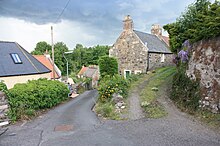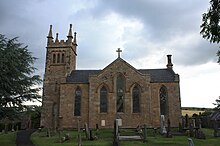Human settlement in Scotland
| Collessie | |
|---|---|
 | |
| Council area | |
| Lieutenancy area | |
| Country | Scotland |
| Sovereign state | United Kingdom |
| Police | Scotland |
| Fire | Scottish |
| Ambulance | Scottish |
| UK Parliament | |
| Scottish Parliament | |
| 56°18′22″N 3°09′18″W / 56.306°N 3.155°W / 56.306; -3.155 | |


Collessie is a village and parish of Fife, Scotland. The village is set on a small hillock centred on a historic church. Due to rerouting of roads, it now lies north of the A91. Though a railway embankment was constructed through the middle of the village in the 19th century, it retains many of its traditional 17th–18th century houses. In recent years some of the older houses have been re-roofed in traditional thatch.
Name
Collessie's name derives from Scottish Gaelic although the exact derivation is unknown. The first element is either cùl (behind) or cùil (nook) and the last element may be either eas (waterfall) or lios (enclosure, garden).
Demographics
The civil parish had a population of 1,921 in 2011.
Notable locations
The Church

The church was consecrated by the Bishop David de Bernham of St. Andrews in July 30, 1243, and is mentioned in charters of both 1252 and 1262. Prior to the Reformation, the church was under the ownership of the Abbot of Lindores and was dedicated to the Virgin Mary.
In 1742 and 1743 the Rev Hugh Blair was the minister of Collessie.
The church was remodelled in 1838–39 by R & R Dickson to a T-plan form with a pinnacled western tower and has remained virtually unchanged since that date. The minister was the Rev John MacFarlane (1798-1875) who served from 1833 but left in the Disruption of 1843. The pulpit is in a central position at the head of the T, as in several Scottish churches including as Currie on the outskirts of Edinburgh. The pews date back to 1911, when they were adjusted to a less upright stance to improve comfort. The font dates from 1928.
The Collessie war memorial is in the east transept. The communion table was brought from Cowlairs Church in 1978 and was their war memorial.
In 2020 the church was listed for sale by the Church of Scotland. As of January 2022, a local resident planned to buy the church and remodel it into a home.
The Churchyard



The churchyard has been in use since at least the 12th century. It was extended in 1840 and 1871 and was taken over by the local County Council in 1929, who still manage it as of 2022.
The Melville Tomb
| This article possibly contains original research. Please improve it by verifying the claims made and adding inline citations. Statements consisting only of original research should be removed. (December 2022) (Learn how and when to remove this message) |
The central feature of the churchyard is 'the Melville Tomb', the mausoleum of the local lairdly family of Melville of Halhill, which was restored from a ruinous condition in 2004. It was erected in 1609 to house the remains of Christian Boswell, the wife of the courtier, diplomat and memoirist Sir James Melville of Halhill. She was a Boswell of Balmuto, an estate north of Burntisland.
Sir James Melville and Christian Boswell had four children; the most well known being the poet Elizabeth Melville, Lady Culross, who named one of her daughters Christian. Presumably, the mausoleum received Sir James's body in 1617, and is now somewhat inaccurately described on the information board next to it simply as 'the tomb of Sir James Melville of Halhill'. The Collessie mausoleum gradually fell prey to neglect and became a ruin: the carved heraldic shields that once filled niches on the walls are gone, as has the date '1609', recorded as late as 1895.
Before restoration, the Melville Tomb was already well known in 'funerary' literature, because it bears two seven-line stanzas of Scots-language verse. These are inscribed on the outer wall, which forms part of the churchyard boundary, and overlooks what was formerly the principal highway to St Andrews. Now damaged, it was transcribed and published complete in 1895.
The Collessie poem makes no mention of Christian Boswell or her husband, but constitutes a short sermon about sin, redemption, death, burial and resurrection. The second stanza sternly denounces the widespread practice of burying bodies inside churches, and its striking first line has twice been used in the titles of articles on burial practices. Both these articles discuss The Blame of Kirk-Buriall, Tending to Perswade Cemeteriall Civilitie, by Mr William Birnie, Minister of Lanark (Edinburgh, 1606), edited W.B.D.D. Turnbull (London, 1833).
- Ye loadin pilgrims passing langs this way
- Pans on your fall, and your offencis past, ponder
- How your frail flesh first formit of the clay
- In dust mon be desolvit at the last:
- Repent, amend, on Christ the burden cast
- Of your sad sinnes, quha can your sauls refresh
- Syne rais from grave to gloir your grislie flesh.
- Defyle not Chrysts kirk with your carrion,
- A soleme sait for Gods service prepard,
- For praier, preaching and communion:
- Your burial suld be in the kirkyaird.
- On your uprysing set your great regard,
- Quhen saull and body ioynes, with joy to ring reign
- In heaven for ay with Christ our head and king.
The poem, which uses 'rhyme royal' (known in Scotland as 'Troilus verse'), has been attributed to Christian Boswell's poet-daughter Elizabeth Melville on biographical and stylistic grounds. The original literary inspiration may have come from an inscription on the wall of Aberdour Kirk on the Fife coast, close to Balmuto Castle and to another Melville family seat, Rossend Castle in Burntisland (home of Elizabeth Melville's uncle Sir Robert of Murdocairnie, and then his son, Sir Robert of Burntisland):
- Pans O pilgrim ponder
- That passith by this way
- Upon thine end
- And thou sal fear to sin
- And think also
- Upon the latter day
- When thou to God man count must give account
- Then best thou now begin then
Which laid out as pentameter verse (with a hypermetric last line) would read:
- Pans O pilgrim that passith by this way
- Upon thine end, and thou sal fear to sin:
- And think also upon the latter day,
- When thou to God man count: then best thou now begin.
It has been suggested that 'pilgrim' alludes to the mediaeval pilgrimages to a well-known, now vanished healing well located near the church. However, 'when' (rather than Scots 'quhen') is suspicious in a supposedly pre-Reformation inscription. The word 'pilgrim' for all human beings on their earthly journey was a standard metaphor much used by Protestants, as the Collessie mausoleum inscription indicates. Elizabeth Melville repeatedly employs the term in her poetry.
It is possible that the Melville tomb inscription provided the inspiration for the Aberdour inscription. If the Aberdour inscription predates 1609 and the Collessie tomb, Elizabeth Melville could have known of it from the man who in 1603 became master of Culross grammar school – her fellow Presbyterian John Fairfoul, former minister of Aberdour, who had become minister of Dunfermline in 1598. Alternatively, Sir James Melville himself may have told his daughter about the Aberdour inscription (he is likely have had considerable input into the content of the poem on his wife's mausoleum). Aberdour is quite close both to Balmuto Castle where Christian Boswell was born, and to another Melville family seat, Rossend Castle in Burntisland, home of Sir James's elder brother Sir Robert of Murdocairnie, 1st Lord Melville, and then of his son, Sir Robert of Burntisland, 2nd Lord Melville. Furthermore, Aberdour Kirk stands next to Aberdour Castle, one of the seats of the Douglas earls of Morton. It was therefore a residence of two important Scottish peers well known to Sir James Melville, namely the Regent Morton (died 1581) and the militantly Presbyterian Archibald Douglas, eighth Earl of Angus and fifth of Morton.
Other notable interments
- Sir William Oliphant Hutchison (1889–1970) artist, President of the Royal Scottish Academy
- John Cheape of Rossie, father of Sir John Cheape
The school
The school and schoolmaster's house date from 1846 providing free education (prior to the Education Act of 1872) from an early date. As with the church, it was designed by R & R Dickson.
Notable residents
- John Balfour of Kinloch
- Rev George Kay minister from 1739 to 1741
References
- "Collessie". Fife Place-name Data. Retrieved 22 May 2020.
- Census of Scotland 2011, Table KS101SC – Usually Resident Population, publ. by National Records of Scotland. Web site http://www.scotlandscensus.gov.uk/ retrieved March 2016. See "Standard Outputs", Table KS101SC, Area type: Civil Parish 1930
- "Collessie Parish Church". POWiS: Places of Worship in Scotland. Scottish Church Heritage Research Ltd. Retrieved 10 December 2022.
- ^ Smith, Craig (24 January 2022). "Plans revealed to create stunning house in historic Fife church on ancient pilgrimage route". Fife Today. Retrieved 30 December 2022.
- "Former Fellows of The Royal Society of Edinburgh 1783 – 2002: Biographical Index Part One" (PDF). The Royal Society of Edinburgh. July 2006. Archived from the original (PDF) on 19 September 2015. Retrieved 29 October 2019.
- ^ Dictionary of Scottish Architects: Dickson
- Guide to Collessie Church
- Ewing, William Annals of the Free Church
- "Ralph Ogg & Partners - Chartered Quantity Surveyors". Raogg.com. Retrieved 24 March 2016.
- "Conservation report - The Melville tomb, Collessie" (PDF). Archived from the original (PDF) on 4 March 2016. Retrieved 1 July 2015.
- "Balmuto Castle | Castle in Kinghorn, Fife | Scottish castles | Stravaiging around Scotland". Stravaiging.com. 20 June 2014. Retrieved 24 March 2016.
- See, for example, Andrew Spicer, ‘"Defile not Christs Kirk with your carrion": The development of burial aisles in post-Reformation Scotland', in P.Marshall and B.Gordon, eds., The Place of the Dead in European Society, 1400–1700 (Cambridge, 2000), pp.149-69. Spicer assigns the date of Christian Boswell’s death to her husband, a mistake which has given rise to published statements that Sir James died in 1609, e.g., in Sarah Tarlow, Ritual, Belief and the Dead in Early Modern Britain and Ireland (2010) and in The Oxford Handbook of the Archaeology of Death and Burial (2013).
- See note 9 above, and also ‘"Defyle not Chrysts Kirk with your Carrion": William Durandus (c.1230-96), a medieval view of burial’, in Monuments and Monumentality across Medieval and Early Modern Europe: Proceedings of the 2011 Stirling Conference, ed. Michael Penman (Donnington: Shaun Tyas, 2013), 212-223.
- See Jamie Reid-Baxter, Poems of Elizabeth Melville (2010), pp.125-26.
- "St. Fillan's Parish Church - Aberdour (Dunfermline), Fife - Places of Worship in Scotland | SCHR". Scottishchurches.org.uk. 7 July 1926. Retrieved 24 March 2016.
- See the notes at the end of: Historic Environment Scotland. "Aberdour Kirk, St Filan's (Church of Scotland)... (Category A Listed Building) (LB3608)". Retrieved 2 April 2019.
- E.g. in Ane Godlie Dreame (1603), Melville calls on God to 'Mak haist to end our painefull pilgrimage' (line 32) ; she also describes herself as 'Ane pilgrime puir consumit with siching sair' (line 108) and the reader as 'Ane pilgrime puir into thy loathsum lyfe' (line 398). See Jamie Reid Baxter, Poems of Elizabeth Melville (Solsequium : Edinburgh, 2010), pp. 73, 76, 88.
- Hew Scott, Fasti Ecclesiae Scoticanae , v, p.27.
- Rossend Castle
- Memoirs of His Own Life by Sir James Melville (Bannatyne Club : Edinburgh, 1827) pp.247-61 ; 300, 325.